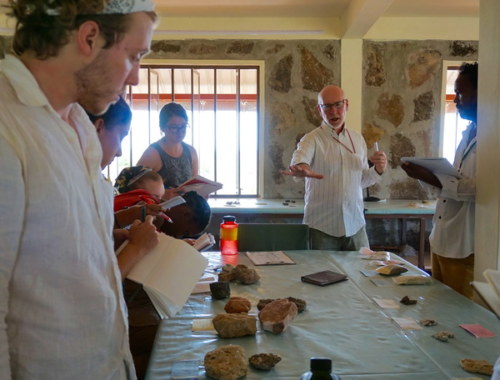
Our Geology module with Dr. Craig Feibel and Dr. Robert Raynolds continues at the TBI campus! Dr. Feibel started off the week with an introduction to the different rock “species” found in the Rift Valley. The students have been working hard to memorize more than 20 different types of rock, as well as state it’s origin (metamorphic, igneous, sedimentary) and chemical make up. We’ve had lots of time to hone our skills on daily hikes into the field, where students can try their hand at identifying rock types and be able to confirm their guesses with the professors. For this module the lab is also set up for the students to see examples of “bioclastic” formations. These are mud or claystones that have shells, algae, fossils, etc., embedded inside them.
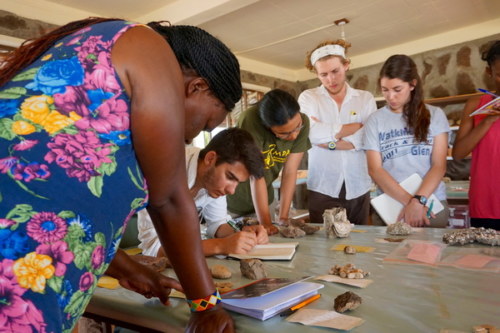
Students taking notes as Dr. Feibel describes the different characteristics of the local Turkana geology. Photo: T.A. Rosie Bryson
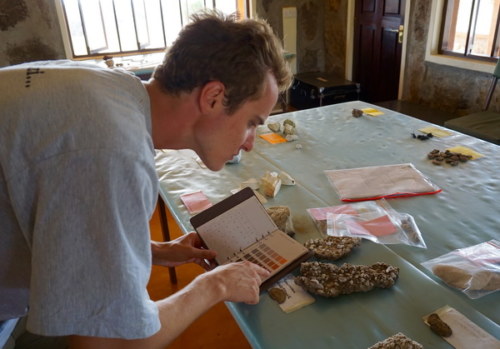
Nick, observing a sandstone that is embedded with ancient mollusks, is trying to identify the exact coloring of the sediment. Photo: T.A. Rosie Bryson
One of the highlights of the week was our long hike into the Koobi Fora formation to see the historic excavation site of a hominid known as KNM-ER 1470. This human ancestor, a Homo rudolfensis found in 1972, was one of the early discoveries of Richard Leakey’s fossil hunting team. This creature lived and died in Turkana approximately 1.9 million years ago. The skull was badly fragmented when it was discovered and had to be carefully reconstructed by the Leakey team, but it proved to be a very valuable find because 1470 exhibits a larger and more globular cranium than its predecessors. This was a crucial step in our evolutionary history because it’s evidence of an expanding brain.
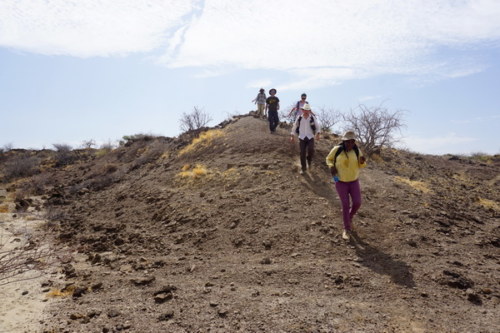
Students hiking into Koobi Fora in search of the KNM-ER 1470 excavation site. (From front to back: Pauline, Tom, Lydia, Nick, Lucy). Photo: T.A. Rosie Bryson
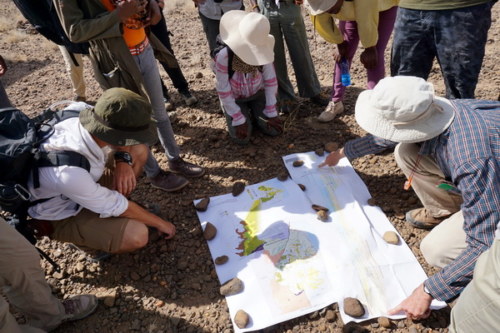
Dr. Raynolds shows the students his map of the Turkana stratigraphy. His mapping work is the compilation of decades of stratagraphic study and the contribution of generations of researchers. Photo: T.A. Rosie Bryson
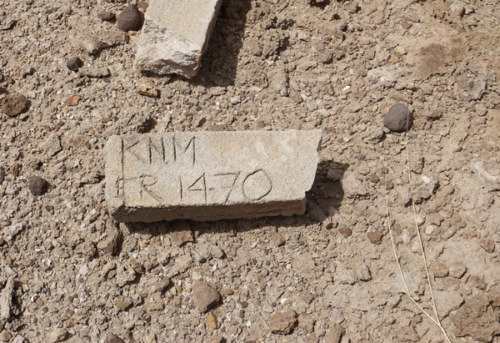
The carved cement marker for KNM-ER 1470 indicating that we were standing on the excavation site. Photo: T.A. Rosie Bryson
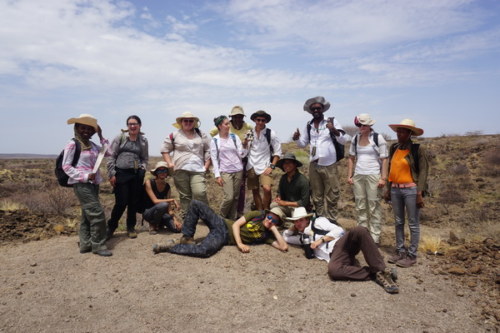
Group photo at the 1470 excavation site! Lydia (center) is holding a cast of the famous Homo rudolfensis that we brought along on the hike with us. Photo: T.A. Rosie Bryson
While we sat at the excavation site at the end of our hike, Dr. Raynolds and Dr. Feibel took the opportunity to explain the dating techniques that were used to assign an age estimate to the discoveries found under our feet long ago. Geologists on the 1972 Koobi Fora Research Project used “tuffs,” layers of volcanic ash in the stratigraphic column, to accurately place the recovered fossils in time. Tuffs are excellent tools for dating fossils because the act of a volcanic eruption essentially stops-the-clock on elements in the volcanic rocks, and they are trapped. Scientists can then measure how much particular elements in the rocks have degraded since the eruption and are able to tell how long ago the layer of ash fell on the earth, and therefore approximately how old the fossilized bones sitting above the tuff are.
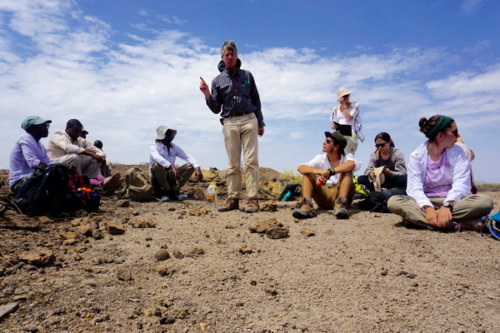
Dr. Raynolds explains the KBS tuff controversy. The students are sitting on the long abandoned excavation site of 1470. Photo: T.A. Rosie Bryson
One of the field skills the students were able to learn this week was how to measure the slope and depth of a stratigraphic column. “Strata” are layers of sediment that have accumulated over time and are used to reconstruct the geological timescale of the Earth and assign a date to fossils. A geologist’s job is easiest when strata lie in what Dr. Feibel refers to as “layer cake” formation, in other words the layers of sediment stack up nicely on top of each other with the oldest at the bottom and the most recent at the top. However with a myriad of geological processes churning and tilting the ground, many stratagraphic columns are not that simple to interpret.
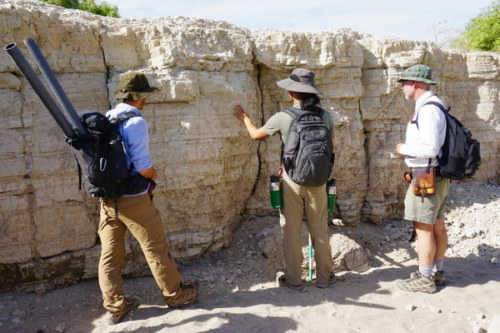
Matt and Rohan discussing stratigraphy with Dr. Feibel. The long black tubes that Matt has in his backpack were used later to collect mud-core samples from the lake shore we hiked to. Photo: T.A. Rosie Bryson
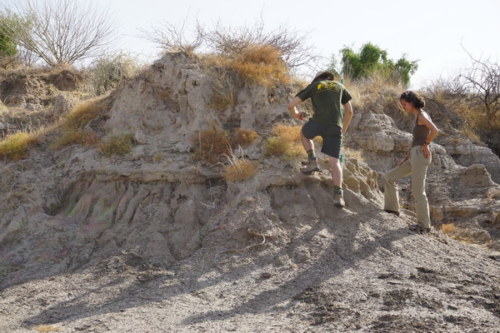
Nick and Regina measuring the slope of the strata just a short hike away from campus. Photo: T.A. Rosie Bryson
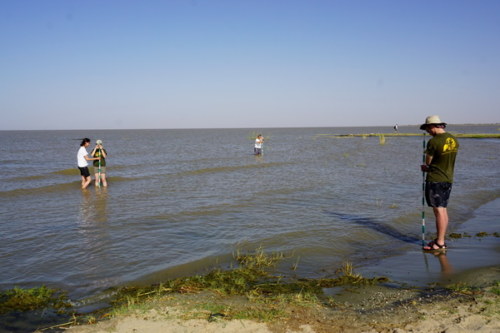
From left to right: Regina, Lydia, Matt and Nick work together to measure the slope of the lake shore using Jacobs staff’s and Brunton compasses. Photo: T.A. Rosie Bryson
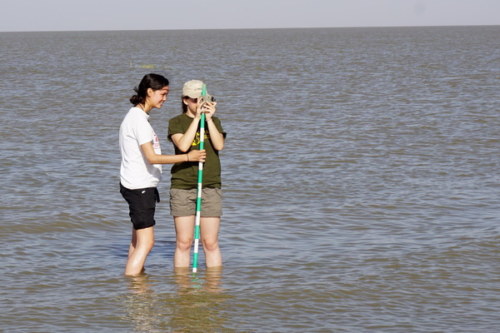
Regina and Lydia working together to get an accurate measurement of the lake bed slope. Photo: T.A. Rosie Bryson
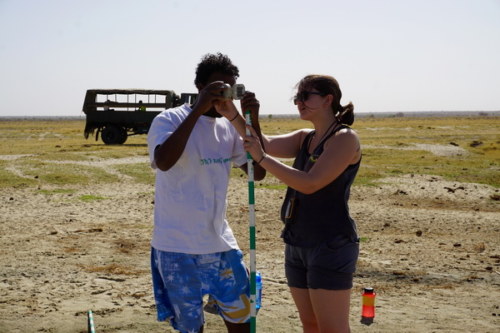
Kifle and Gill using their compass to align with their partner Ann, not pictured, who was standing in the lake. Photo: T.A. Rosie Bryson
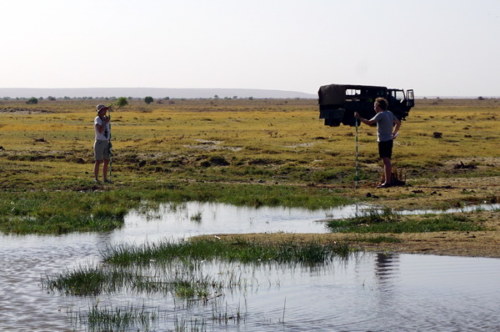
Ulla (left) and Tom (right) calculating the gradual slope of the lake shore. Photo: T.A. Rosie Bryson
The students practiced measuring strata in the tall cliff exposures that surround our campus and at the lake shore which is only a short drive away. They worked in groups using a compass and Jacob’s staffs (1.5m poles with 10cm gradations used for measuring in the field) to carefully measure the inclination of the slope from land into the water. This technique is used to tell us how the lake boundaries have changed over time. As we looked across the landscape we were able to see, through the changing topography, how much larger the lake was only a few thousand years ago. They also collected “mud-cores,” a vertical section of sediment, from Lake Turkana which we will examine later next week.
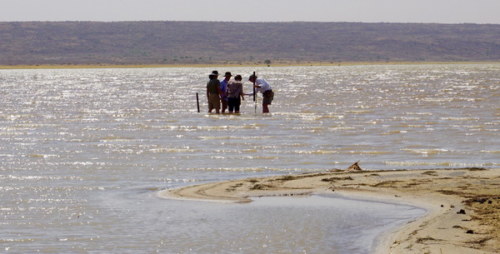
Gill, Matt and Rohan helping Dr. Feibel collect core samples from the lake. Photo: T.A. Rosie Bryson
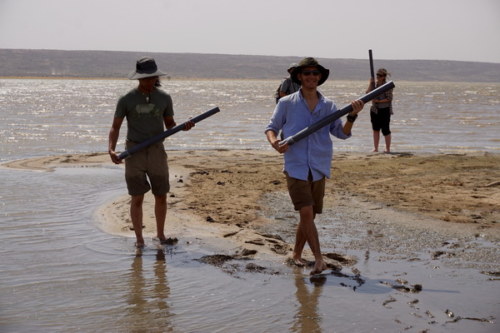
Our triumphant team returns from core sampling! Slightly muddy, but nonetheless cheerful and successful. Photo: T.A. Rosie Bryson
The students are becoming more and more comfortable using their GPS to navigate around the fossil-rich areas that surround the TBI campus. This week one of their assignments was to complete an Orienteering Competition meant to test their ability to travel by compass and GPS. In teams, they raced through a large desert course following prompts such as, “Using your GPS go to 4° 16.801’ N, 36° 16.190’ E.”
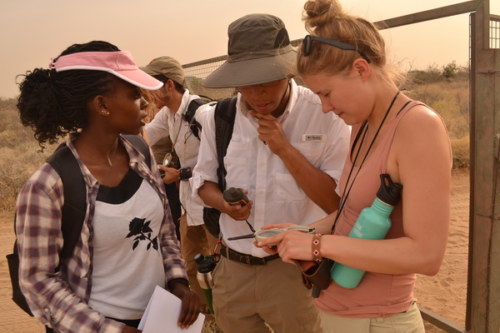
Ann, Rohan and Ulla. Photo: T.A. Ester Kadaga
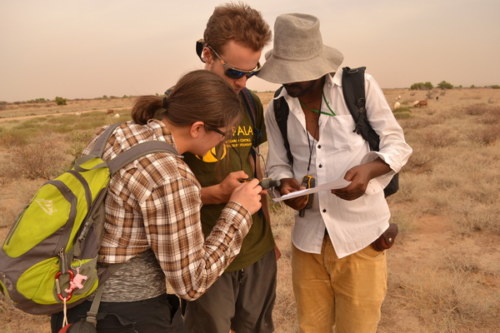
Gill, Nick and Kifle. Photo: T.A. Ester Kadaga
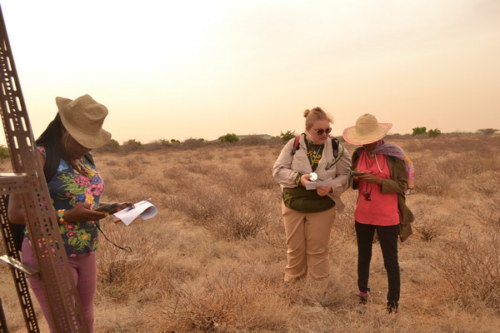
Pauline, Meaghan and Georgina. Photo: T.A. Ester Kadaga
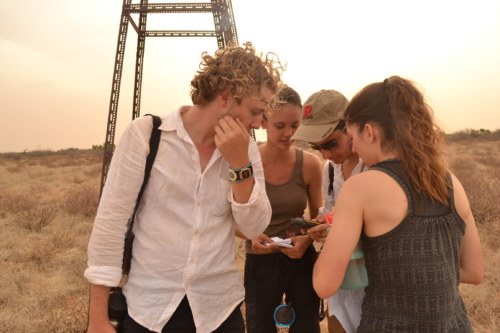
Tom, Regina, Matt and Lydia. Photo: T.A. Ester Kadaga
Sundays on campus signal a break from classes, a morning trip to the lake and a friendly, but fiercely competitive, soccer match between staff and students! This weekend we were treated to the surprise of inner tubes to take with us to the lake, which the students thoroughly enjoyed. After the beach we headed back to campus to relax and got a late afternoon tour of the TBI greenhouse.
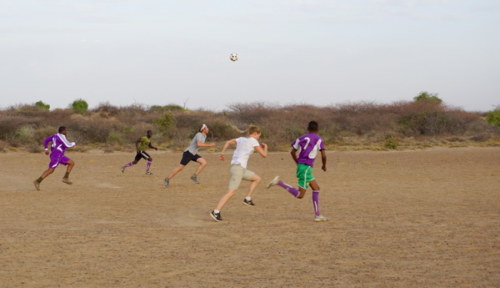
Ulla and Tom race to get the ball first. Photo: Gill Pollhein
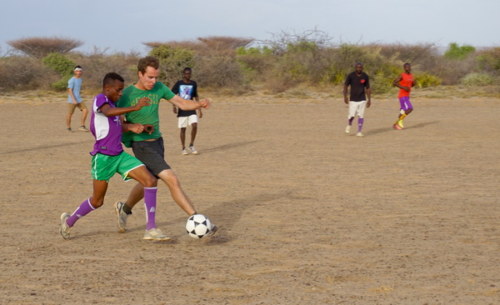
All-star player Nick snatches the ball away from one of the TBI staff. Photo: Gill Pollhien
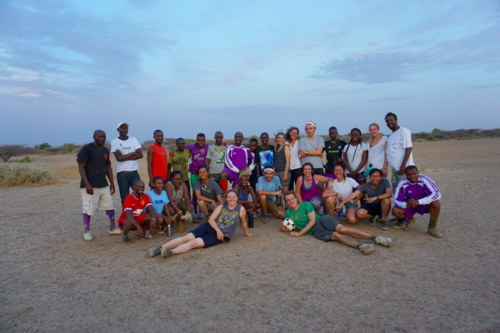
Team photo! The TBI staff vs. the field-school students.
The hydroponic greenhouse on campus is a new addition in recent years. It now can produce 20% of the campuses vegetable needs and its production is growing every year. The greenhouse manager Michael showed us their soil-free growth system designed intentionally for the harsh desert environment of Turkana. The plants are grown in a mixture of “coco-peet,” a mulch of coconut rinds, and pumice stones, which are an abundant resource in this area with all the ancient volcanic eruptions of the Rift Valley. Among other things Michael is growing beans, butternut squash, spinach, chili peppers, and even a young mango tree! (Much to our delight).
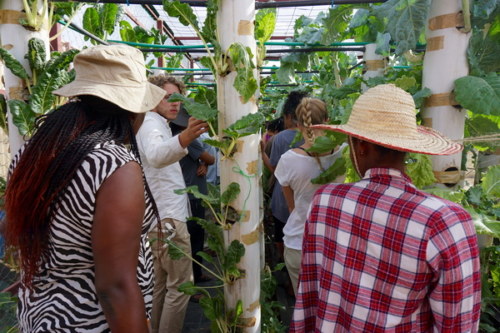
Pauline, Tom, Ulla and Georgina explore the TBI greenhouses and learn about the hydroponic system that produces many of the vegetables we eat everyday. Photo: T.A. Rosie Bryson
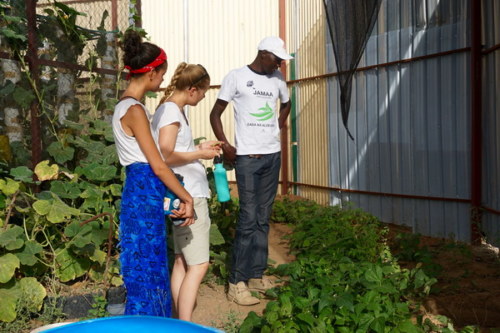
Regina and Ulla listen to Michael describe the different species of plants that he grows at TBI. Photo: T.A. Rosie Bryson
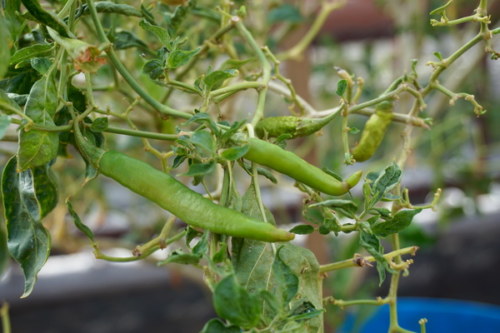
TBI grown Chili Peppers. Photo: T.A. Rosie Bryson
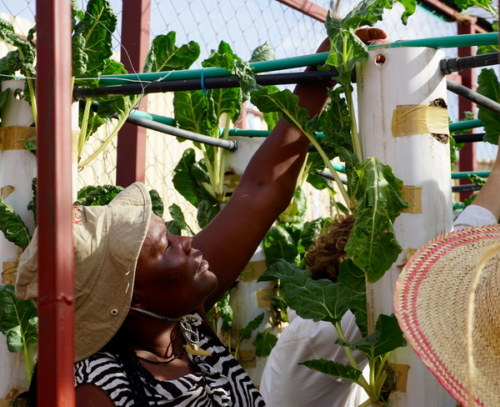
Pauline examining the PVC tubing structure that Michael uses to grow the TBI plants. Photo: T.A. Rosie Bryson
One of our Kenyan students, Pauline Mbatha, was keenly interested to try the techniques she learned at the greenhouse in her own village, which also struggles with lack of arable soil and water availability. We hope that she takes on that new project and can’t wait to see what she can grow!
Tomorrow we head out on a 3-day camping trip to Koobi Fora, where the students will sleep (with bug nets, of course) under the stars and hike in exposures over 1 million years old. Stay tuned!





